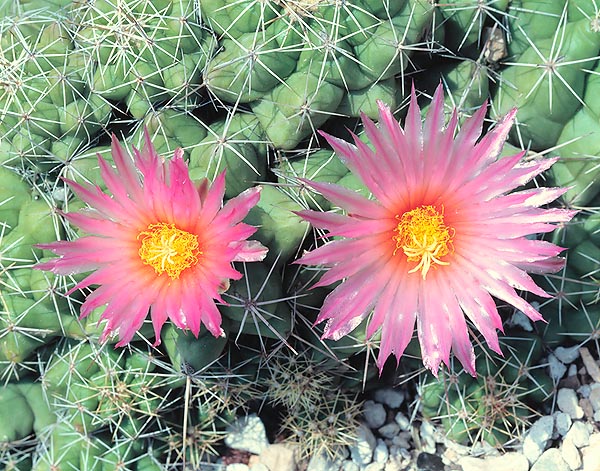Family : Cactaceae

Text © Pietro Puccio

English translation by Mario Beltramini
The plant is native to Mexico, where it grows in semi-arid areas, in association with thorny shrubs, on calcareous soils between the 1.200 and the 2.000 m of altitude. The are two recognized subspecies: the Thelocactus leucacanthus subsp. leucacanthus, native to the state of Hidalgo, with yellow flowers, and the Thelocactus leucacanthus subsp. schmollii, native to the state of Queretaro, with intense magenta flowers and tubercles usually greater than those of the previous one.
The name of the genus comes from the combination of the Greek word “thelé” = nipple and Cactus, with reference to the tubercles on the ribs; the name of the species is the combination of the Greek words “leukόs” = white and “akantha” = thorn, with obvious reference. Common names: “biznaga-pezón de espinas blancas” (Spanish-Mexico).
The Thelocactus leucacanthus (Zucc. ex Pfeiff.) Britton & Rose (1923) is a plant with pale green stems which, in the wild, forms wide compact tufts with even a diameter of one metre; the stems, globose or slightly elongated of 4-6 cm of diameter and 6-14 cm of length, have 7-13 ribs almost indistinct with conical tubercles, prominent, about 1 cm long and 1,4 cm broad, with rounded apex.

Even 1 m broad tufts with yellow, magenta or crimson flowers. Easy tilling © Giuseppe Mazza
The downy areoles, oblong, about 6 mm long, are equipped with nectar glands and have 6 to 20 radial thorns, about 6 mm long, of a yellowish-white colour tending to the grey or the reddish with the age, and a central thorn, not always present, long from 1 to 5 cm, of an initially blackish colour, tending to the yellowish-white with the age.
The flowers generate at the apex of the stem, are funnel-shaped, with ovary and floral tube covered by broad imbricate scales, 3-5 cm long and 4-5 cm broad, of yellow colour (subsp. leucacanthus), or from to magenta to crimson colour (subsp. schmollii), and open in the morning and close in the evening for some days. The fruits are globose, 0,5-1 cm of diameter, covered by scales, greenish-yellow and contain black pear-shaped seeds, long up to 2 mm. It reproduces by seed and by division.
Plant of easy cultivation to be positioned in full sun, or, however, at the maximum possible luminosity, on particularly porous and draining soils which may be formed for about the 50% by common fertilized garden earth and for the rest, in equal proportion, by sand (agri-perlite) and crushed dust-free stone. Though it is rather resistant to the low temperatures, as it can stand, completely dry and for short time, temperatures as low as -4/-6° C, it is better, in order to avoid rottenness, not to expose it to temperatures close to the 0° C.
Its best positioning in open air, where the climate allows this, is in “desert” gardens along with other xerophytes, elsewhere, it is to be cultivated in pot with the same aforementioned modalities. In summer, during the vegetative period, it is to be regularly watered, but allowing the mould to dry up completely before irrigating again; in winter, it is to be kept dry and with rather low temperatures, between +5 and +10° C, this resting time, cold and dry, is indispensable for a good blooming.
The plant is inscribed into the appendix II of the CITES (plant whose trade is ruled at international level).
Synonyms: Echinocactus leucacanthus Zucc. ex Pfeiff. (1837); Echinocactus ehrenbergii Pfeiff. (1838); Echinocactus porrectus Lem. (1838); Thelocactus ehrenbergii (Pfeiff.) F.M. Knuth (1935); Thelocactus porrectus (Lem.) F.M. Knuth (1935); Thelocactus leucacanthus var. porrectus (Lem.) Backeb. (1961); Ferocactus leucacanthus (Zucc. ex Pfeiff.) N.P. Taylor (1979); Thelocactus leucacanthus var. ehrenbergii (Pfeiff.) Bravo (1980).
